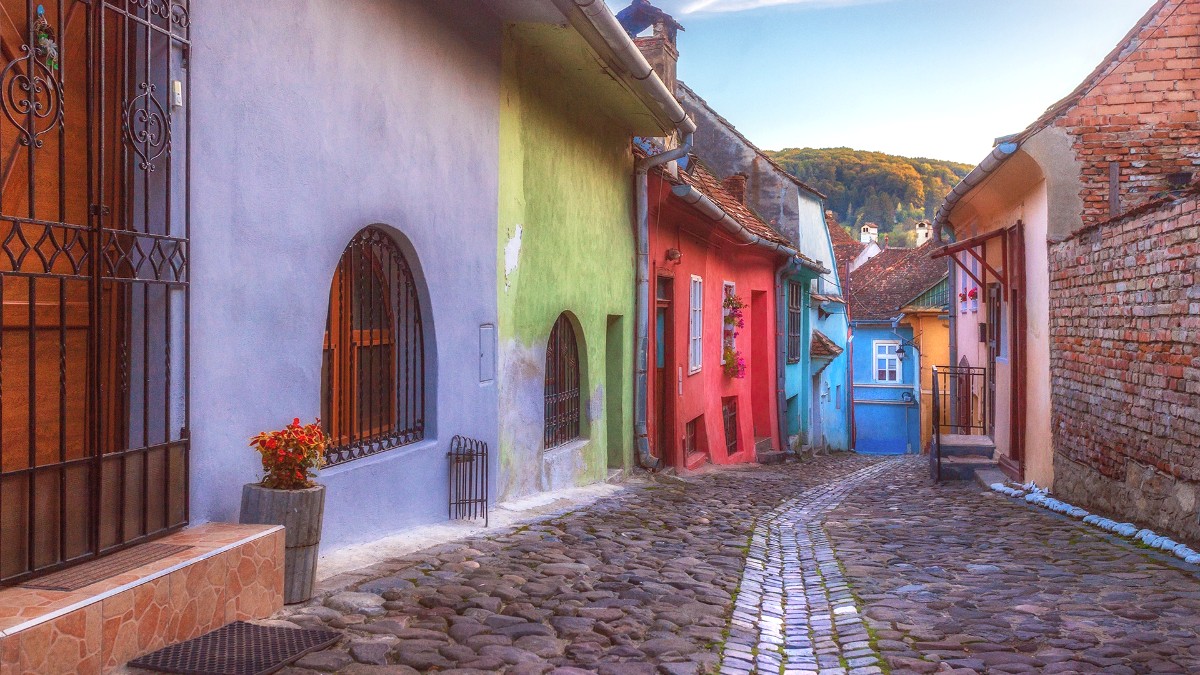
Transylvania, Romania
The historical sites of Sighisoara Citadel immerse you in a past era. Every structure speaks of centuries of Transylvanian history and Saxon craftsmanship. Walking through the cobbled streets transports you to a bygone time.
These landmarks are well-preserved and offer a direct connection to medieval life, making them essential stops for any visitor.
Each site offers a glimpse into Sighisoara's rich heritage.
Visit attractions before 09:00-10:00 or after 18:00 to encounter fewer tour groups. Mondays, when the Clock Tower Museum is closed, can also be calmer.
The cemetery next to the Church on the Hill presents calm and wide views over the town and valley. It offers a peaceful place for reflection and photography.
Wander along the outer defensive walls. Different sections have good, less-frequented spots for scenery.
Sighisoara’s museums and cultural venues offer insight into its history, art, and the daily lives of past residents. They give context to the medieval environment.
Found inside the Clock Tower, this museum shows Sighisoara's past as a Saxon fortified town. Exhibits include regional archaeological finds, medieval artifacts, Saxon crafts, and old clocks/furniture. Its location in the tower creates an unique experience.
A small museum next to the Vlad Dracul House. It shows medieval weapons, armor, and historical torture devices. This museum presents a glimpse into the military side of medieval life and old justice systems.
At the base of the Clock Tower, this small display shows various medieval torture tools. It acts as a reminder of the harsh realities of medieval justice. Entry typically needs a separate or combined ticket.
Major art galleries are not a main feature. However, many smaller artisan shops within the Citadel display and sell local art and crafts, like traditional Romanian painting, pottery, textiles, and wood carvings. You can find unique pieces directly from local artists.
Sighisoara lacks dedicated, year-round performance venues. Its squares and historic buildings frequently host events, especially in warmer months. The annual Sighisoara Medieval Festival transforms various squares into stages for themed performances and reenactments.
Special exhibits are uncommon outside the Sighisoara Medieval Festival. During the festival, museums and public spaces might host temporary displays about medieval life, crafts, or history. Check local tourism offices for specific events during your visit.
Beyond museums, the town itself is a living lesson. Walk through the Citadel's streets to observe Saxon architecture, and look for artisan shops where local creators display their traditional crafts. These informal spaces often convey local artistry.
Sighisoara functions as a living historical site, with its entire core designated an UNESCO World Heritage site. Beyond the main landmarks, every part of the Citadel unfolds layers of its past.
Its continued inhabitation means structures built upon previous ones, not as uncovered ruins. However, the History Museum displays finds that show earlier settlements. The architecture mainly shows its Transylvanian Saxon founders' style, along with later influences.
The entire Historic Centre of Sighisoara is an UNESCO World Heritage site. Its architectural style largely reflects its Transylvanian Saxon founders.
Sighisoara has several churches, each with its own history and style.
Various markers and monuments recall figures and events in Sighisoara's past.
Sighisoara's military past is vividly present in its defensive walls and guild towers.
While Sighisoara is known for its history and architecture, its natural surroundings offer a pleasant contrast and spots for relaxation and scenic views.
The Citadel itself has small green spaces. In the Lower Town, local parks exist for relaxation, picnics, or walks. The Sighisoara Oak Tree Reserve, a short drive away, features ancient oak trees for a peaceful natural escape.
The top of the Clock Tower presents the most comprehensive panoramic views of the Citadel, Lower Town, and the Târnava Mare Valley. The cemetery next to the Church on the Hill also offers wide and calm views over the town and valley.
The forested hills and rural areas around Sighisoara are home to deer, wild boar, and many bird species. While dedicated viewing spots are not set up nearby, nature walks might lead to incidental wildlife sightings. For focused encounters, like bear watching, travel to specific Carpathian Mountain regions.
No major geological features like canyons, caves, or unique rock formations are directly in Sighisoara or its immediate surroundings. The landscape consists of rolling hills and river valleys.
The Târnava Mare River flows through Sighisoara, but it is not for swimming, boating, or beach activities within city limits. No major beaches or large lakes suitable for recreation are located nearby.
Beyond the popular paths and landmarks, Sighisoara holds several hidden gems and local favorites that present a , more authentic experience for the curious traveler.
Discover less-visited spots that still carry significant charm and history.
Experience authentic local life away from the tourist buzz.
Explore the surrounding Saxon villages for a cultural journey.
These spots are great for day trips from Sighisoara or longer cultural immersions.
Capture Sighisoara's distinctive charm from fresh perspectives.
The changing light dramatically highlights the towers and walls against the sky.
Discover hidden perspectives for striking imagery.
These lesser-known spots yield truly memorable photos.
Stepping off the main tourist paths often leads to more genuine interactions and discoveries of local life.
Purchasing from small artisan shops or visiting local markets directly supports the community and its traditional crafts.
These hidden gems often let you slow down, observe, and truly absorb the atmosphere of Sighisoara beyond its main attractions.